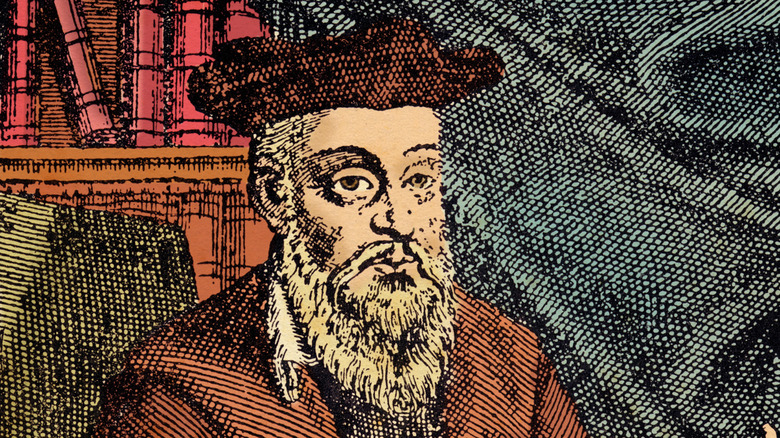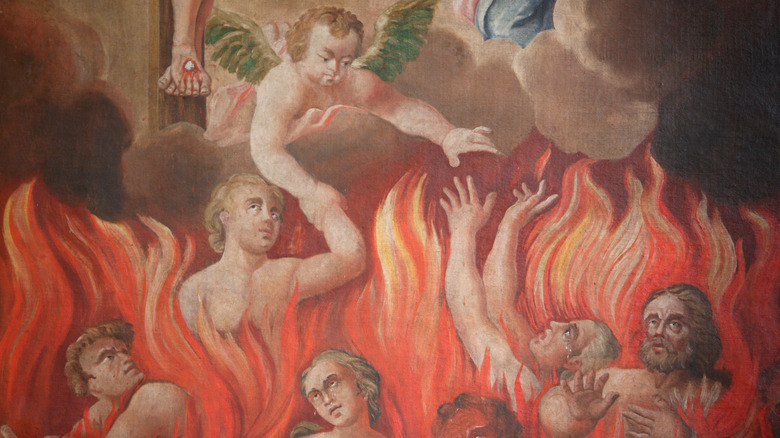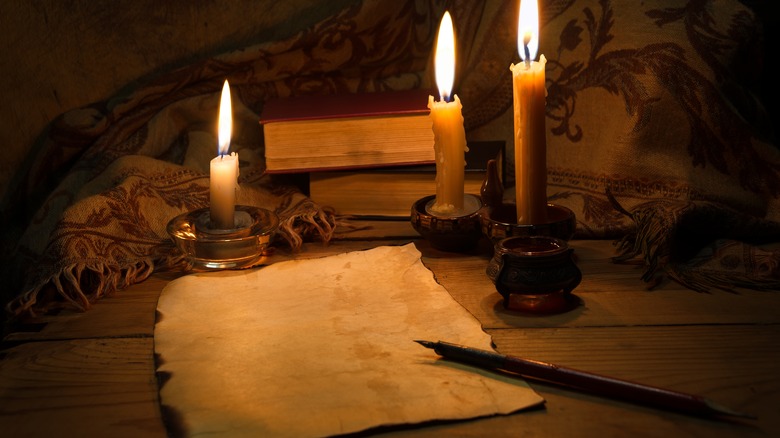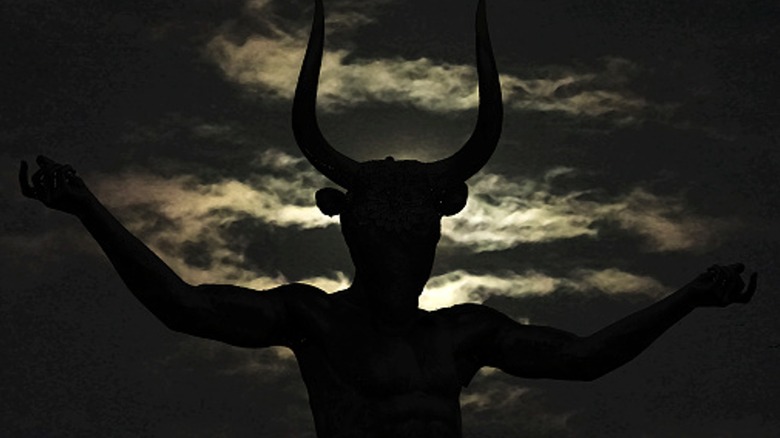Chilling Times Nostradamus Predicted The Antichrist
It's once again time to choose your favorite Nostradamus apocalyptic bugbear and/or deathly portent. The usual suspects include fire, floods, blood, famine, some beasts and plagues, and of course: the Antichrist. Or is it antichrist with a small "a"? We'll get to that. But the truth is, history's most often-cited 16th-century French prognosticator didn't really say much about the entity or persona we've come to define as "the antichrist." Maybe all the pleasant-smelling, herb-infused water that Nostradamus gazed into to write his poetry — i.e., see his visions — put a limit even on his capacity for doomsaying.
For this discussion, we can turn directly to Nostradamus' famed 1555 book of supposed prophecies, "Les Prophesies" ("The Prophecies"). Nostradamus separated his prophecies by centuries one through 10, each century divided by year, and each year described using a quatrain — four lines of poetry. "Blood" comes up a lot in "The Prophecies," like we mentioned — 125 times, to be exact. "Death" comes in a close second at 122 times, and then we've got other mentions like famine at 32 times. The antichrist? He only gets mentioned twice. In "The Prophecies'" opening letter to King Henry II, though — the husband of Nostradamus' chief patron, Catherine de Medici — Nostradamus mentions the antichrist four times. He must have known his audience.
But bear in mind that Nostradamus wrote "The Prophecies" about 470 years ago. Ideas about the antichrist were different back then, and we really don't know in what sense Nostradamus used the term.
Liar, beast, pope, and more
Before discussing either Nostradamus or the antichrist we need to answer a simple question: Who or what actually is the antichrist? Looking to the Christian Bible — the source of the term — the antichrist doesn't show up until the New Testament book 1 John 2:22: "Who is the liar? It is whoever denies that Jesus is the Christ. Such a person is the antichrist — denying the Father and the Son." 2 John 7 also says that anyone "who do not acknowledge Jesus Christ as coming in the flesh ... is the deceiver and the antichrist." Over time the term "antichrist" got connected to the apocalyptic book of Revelations chapter 13, which talks about the famous beast with "ten horns and seven heads, with ten crowns on its horns" rising from the ocean.
As the Conversation explains, the antichrist narrative coalesced around 1,000 C.E. thanks to Benedictine monk Adso of Montier-en-Der, who said the antichrist would be a Jew hailed as a false Messiah. Over the centuries, it became commonplace for opponents of church and political leaders to cry "antichrist," like when Englishman John Wycliffe called the Pope an antichrist in the 14th century. The 16th-century Protestant Reformation leader Martin Luther also called the pope of his day an antichrist.
So when Nostradamus wrote about antichrists in his 1555 book, "The Prophecies," he was building on this bedrock of knowledge and common parlance. Whether he was using the term generally or thinking of a specific biblical version of antichrist figures is unknown.
Nostradamus' letter to King Henry II
We said that Nostradamus mentions the antichrist a bunch in "The Prophecies" letter to King Henry II. Nostradamus used this letter to the French king to summarize his predictions and present them in a far more dire way than his prophecies do. He describes calculating the years of his prophecies using a biblical reckoning of time from the mythical creation of Adam, the first man. He also covers himself by saying that his quatrains are "so ticklish that there is no making way through them, nor is there any interpreting of them." Remember this point.
In the letter Nostradamus mentions multiple "Antichrists" with a capital "A," each one presented as opposing the Roman Catholic Church. In a wild, Hollywood-type good vs. evil tale full of conquest, destruction, and political intrigue, Nostradamus says that the first "Empire of the Antichrist" will "descend with great and countless numbers" like the ancient Persian king Xerxes onto Rome. But, he'll be thwarted by the "Holy Ghost," which Nostradamus equates to some astrological calculations.
The second Antichrist, Nostradamus says, will rise in the Adriatic Sea after 1792 C.E. and wield the power of three kings "seduced by tongues." Then we get blood, floods, some pestilence, and a third Antichrist — "the infernal prince" — subjugating the world for 25 years leading into a new Saturn-ruled, golden age. Those 25 years feature the destruction of cities, a "great effusion of vestal blood," "violations" of various women, and "sucking children dashed and broken against the walls of towns."
Some typical talk of blood, death ... and blood
Looking at Nostradamus' actual prophecies in "The Prophecies," we only see the antichrist mentioned twice. And if you guessed that these passages contain plenty of savage violence, tyrannical monarchs, dead children and such: Congratulations, you've correctly predicted Nostradamus' predictions.
The first mention of the antichrist — this time with a small "a" for some unknown reason — comes late in "The Prophecies" in Century VIII, quatrain 77. The lead-in describes a garbled mess of political infighting, lawlessness, ruthless murder and the like. Highlights include a looted temple, an "adulterer" who murders his wife and child (the latter by strangulation), a secret inscription found in an "ancient cave," a fallen angel, banned books (around the year 1607 C.E.), a big battle, some dude eating horse meat, a "barbarian soldier" killing a king, a father and son "murdered together," a "butcher" arising from a lowly birth to rule the British empire, and finally the antichrist himself. Too bad Nostradamus wasn't around to write a blockbuster action flick.
If all of this sounds hard to follow, remember that Nostradamus admitted as much in his letter to King Henry. The antichrist quatrain, which doesn't necessarily connect well to what comes before or after, reads in full: "The antichrist very soon annihilates the three / twenty-seven years his war will last / The unbelievers are dead, captive, exiled / with blood, human bodies, water and red hail covering the earth." Vivid and ominous language aside, the antichrist here remains a mysterious figure.
The false Antichrist cometh
The next and final time the Antichrist — capital "A" this time — shows up in "The Prophecies" it isn't until near the end in Century X, quatrain 66. This quatrain is even more disconnected from its adjoining lines than the first one, but it still sounds horrifying in Nostradamus' vague way. After name-dropping a mess load of European cities that will be crippled by war, fire, and — you guessed it — blood, Nostradamus again turns his attention to Rome, saying, "Thy ruin approaches."
Then we get the antichrist poem. It reads in full: "The chief of London through the realm of America / The Isle of Scotland will be tried by frost / King and Reb will face an Antichrist so false / That he will place them in the conflict all together." Who or what the heck is "Reb," you may ask? No clue. The "them" placed in conflict is presumably the king of London, America, and possibly Scotland who will face off against the Antichrist. But, this antichrist is also "false," meaning he's not a real antichrist, anyway. If this is true, then the only time Nostradamus talks about a real antichrist in his prophecies is the previous time in Century VIII, quatrain 77.
And just to illustrate why we're not talking about interpretations in this article: One would-be prophetic interpreter on Quora analogizes Russian President Vladimir Putin to a false antichrist, and former U.S. President Barrack Obama to a real antichrist. So yeah — best stick to Nostradamus' advice and not bother with interpretation.




